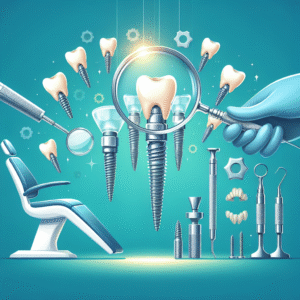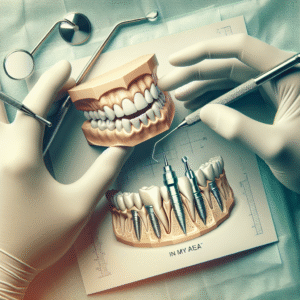Understanding the All-on-4 Dental Implant Procedure
The All-on-4 dental implant procedure represents a significant advancement in restorative dentistry, specifically designed for individuals facing substantial tooth loss. This innovative approach utilizes only four strategically placed dental implants for each arch of prosthetic teeth, offering a practical solution for those seeking a complete restoration without the need for multiple implants. The technique is particularly advantageous for patients who may have experienced bone loss in the jaw, an issue that often complicates traditional dental implant procedures.
During the All-on-4 procedure, the two posterior implants are angled to maximize the use of existing bone, while the anterior implants are placed vertically. This unique configuration not only enhances stability but also allows for a reduced treatment time, often enabling immediate placement of a temporary prosthesis on the same day as the surgery. In contrast, traditional implant approaches typically necessitate more implants for the same level of support, often requiring longer healing periods and increased surgical complexity. The All-on-4 method minimizes these drawbacks, making it an appealing option for patients pursuing a swift return to normal function and aesthetics.
An additional benefit of the All-on-4 dental implant procedure is its cost-effectiveness compared to the cumulative expenses of traditional implant alternatives. By significantly lowering the number of required implants, patients can achieve substantial savings while still receiving a high-quality, durable restoration. Overall, this method is designed to provide patients with a functional solution that addresses both aesthetic and practical concerns, allowing them to regain their confidence and quality of life.
Advantages of the All-on-4 Procedure
The All-on-4 dental implant procedure offers a multitude of advantages that make it a compelling option for individuals seeking dental restoration. One of the most notable benefits is the significantly faster recovery time compared to traditional implant methods. Due to the strategic placement of implants, many patients experience reduced discomfort and can return to their daily activities sooner. This is particularly advantageous for those who may have previously experienced hesitance regarding lengthy recovery periods associated with other dental restoration techniques.
Another significant benefit of the All-on-4 procedure is its reduced need for bone grafting. Many patients suffer from bone loss in the jaw, which can complicate implant placement. However, the All-on-4 technique utilizes the existing bone structure in a more efficient manner, allowing for immediate implantation without the need for extensive grafting procedures. This not only simplifies the process but also lowers the associated time and financial costs, making it a more appealing option for many patients.
Additionally, the All-on-4 procedure allows for the immediate restoration of teeth. Following the placement of the implants, a temporary set of teeth can often be affixed on the same day, enabling patients to leave the dental office with a functional and aesthetic smile. This immediate benefit enhances the quality of life for individuals who have been living with compromised dental health, allowing them to enjoy meals and social interactions more comfortably.
Moreover, the All-on-4 approach is typically more cost-effective when compared to other dental restoration options. With fewer implants required and less need for supplementary procedures, patients find this treatment often falls within a more affordable range, making it accessible to a broader audience. Overall, the All-on-4 dental implant procedure encompasses significant advantages that promote both oral health and patient satisfaction.
Who is an Ideal Candidate for All-on-4 Dental Implants?
The All-on-4 dental implant procedure provides a transformative solution for individuals seeking full arch rehabilitation. However, not everyone is a suitable candidate for this treatment. Several factors come into play when determining whether a patient can benefit from the All-on-4 dental implants, including their bone density, overall health, and oral health history.
Firstly, the condition of the jawbone is critical. All-on-4 implants require sufficient bone density to anchor the dental implants securely. Patients who have experienced bone loss due to periodontal disease or prolonged tooth loss may need bone grafting or other interventions to enhance their candidacy. Conversely, individuals with adequate bone structure will find the All-on-4 procedure particularly advantageous, as it is designed to utilize four strategically placed implants to support an entire arch of teeth, often without the need for extensive bone grafting.
Furthermore, the overall health of a patient is another significant consideration. Those with chronic medical conditions, such as uncontrolled diabetes or cardiovascular diseases, may face increased risks during and after the surgical procedure. It is imperative for interested candidates to undergo a thorough health evaluation, as well as discuss any pre-existing conditions with their dental care provider. This dialogue ensures that all factors relating to their health are adequately addressed before proceeding with the implants.
An individual’s dental history also plays a crucial role in their eligibility. Patients with a significant history of dental issues, such as tooth decay or gum disease, should undergo an assessment to determine if these problems have been managed effectively. A personalized consultation with a dental professional is essential, as it provides the opportunity for tailored recommendations based on the patient’s unique needs and circumstances. Engaging in open discussions during this consultation work together to establish a feasible and effective treatment plan for interested candidates.
Post-Procedure Care and Maintenance
Following the All-on-4 dental implant procedure, it is crucial for patients to adhere to a specific care regimen to ensure optimal healing and longevity of the implants. One of the primary aspects of post-procedure care is maintaining proper oral hygiene. Patients are encouraged to brush their teeth at least twice a day with a soft-bristled toothbrush and use non-abrasive toothpaste to prevent damaging the implants or surrounding gums. Flossing should also be incorporated, preferably using floss designed for dental implants, which helps in cleaning between the artificial teeth and maintaining overall oral cleanliness.
In addition to oral hygiene, dietary choices during the healing phase play a significant role in recovery. Patients are advised to consume a diet that is rich in nutrients while avoiding hard, crunchy, or sticky foods that could potentially dislodge the implants. Soft foods, such as yogurt, smoothies, and mashed potatoes, are recommended to minimize discomfort and support the healing process. Staying hydrated is equally important, as it helps facilitate healing and promotes overall well-being.
Routine dental check-ups must also be scheduled after the All-on-4 procedure. These visits allow the dental professional to monitor the condition of the implants, ensuring they are integrating well with the jawbone and that no complications arise. Regular cleanings performed by a dental hygienist are essential to remove plaque and tartar buildup, which can affect both implants and remaining natural teeth.
The importance of adhering to these care practices cannot be overstated. Proper post-procedure care not only enhances the longevity of the All-on-4 dental implants but also contributes to maintaining overall oral health. By following the recommended hygiene routines, making appropriate dietary choices, and attending regular dental appointments, patients can enjoy the full benefits of their dental implants for years to come.




